When it comes to teaching comparing 3 digit numbers in 2nd grade, I like to teach it in a way that helps students find success in math throughout their entire schooling.
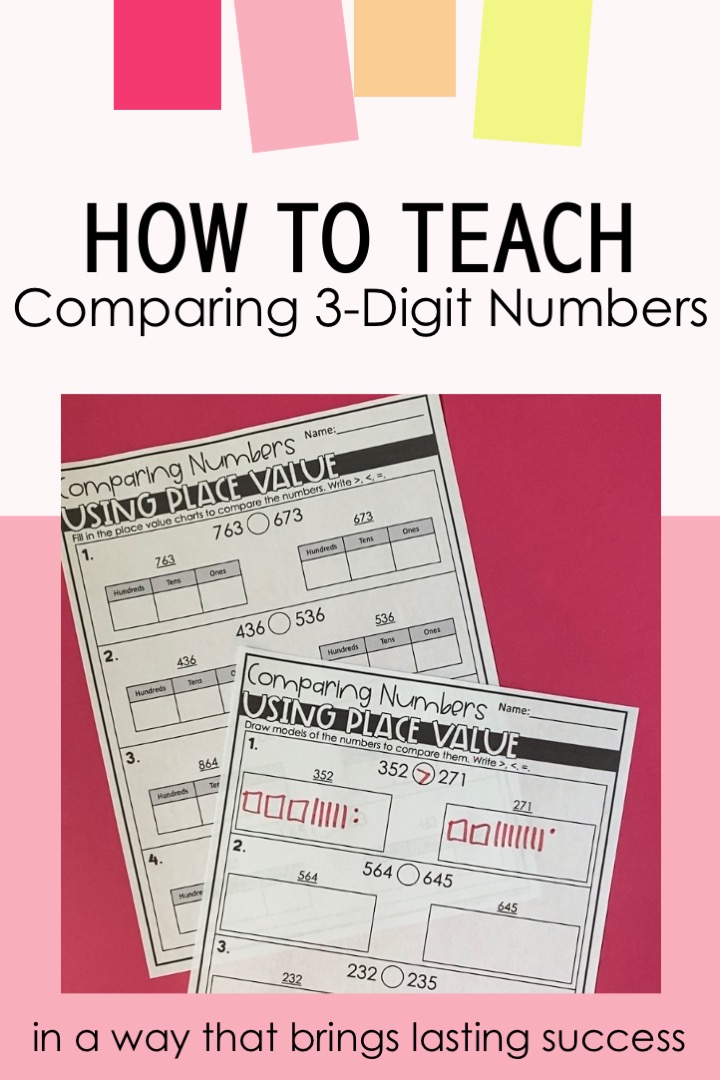
Teach comparing 3 digit numbers in a way so that students can be successful not only on worksheets, but using inequality symbols their entire life.
Let me explain a little on what I mean by that. When I was a junior in high school, I was in a pre-calculus class and we were working on inequalities. These are equations that look something like this: 2x + 1 < 9. When you solve this inequality it ends up being x < 9. I solved an equation like this in class and the teacher called on me to say the answer and I didn’t know how to say the answer…
Want to know why? I had always learned the alligator trick when it comes to comparing numbers. The mouth opens and wants to eat the bigger number. But that makes it really tricky when x is involved. I didn’t know if I should say “x is less than 9” or “x is greater than 9.”
But here’s the thing… I wasn’t the only student who struggled with this in my pre-calculus class! So many others also struggled to know what to say since they were also taught these the same way in elementary school.
So I knew when I became a 2nd grade teacher and taught comparing 3 digit numbers, I didn’t want to use the alligator trick. That does help students in the moment to complete a comparing numbers worksheet, but it doesn’t help them long term to know what those symbols mean and represent.
That’s why today I am sharing exactly how I teach comparing 3 digit numbers to my 2nd grade students in a way that brings lasting success.
But first… If you’re a parent who has a child struggling with math, you’ve got to check out Learner. Learner is an online tutoring platform that sets students up for success. To get started take a short quiz about your child’s needs. Then Learner’s Success Management Team reviews that and matches your child with the perfect tutor. Get your $25 trial here.
Comparing 3 Digit Numbers
For 2nd grade, the common core state standard says this, “Compare two three-digit numbers based on meanings of hundreds, tens, and ones digits, using > ,=, and < symbols to record the results of comparisons.”
To help my students compare these numbers, I like to first represent the two numbers with base ten blocks. I have my students help me build these and we also fill out a hundreds, tens, and ones chart. Simply I ask my students how many hundreds each number has, how many tens, and how many ones. We fill those in the chart. Then I ask, “When comparing, should we start with the hundreds or the ones?” Students know that we should start with the hundreds because hundreds have more value than ones.
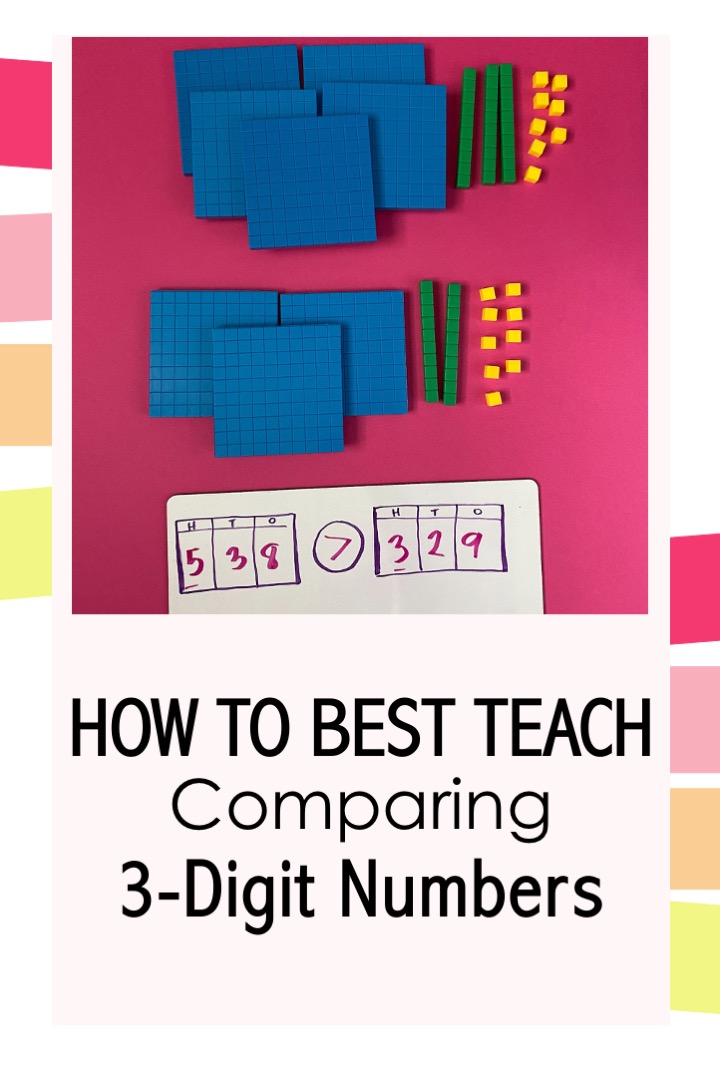
When it comes to teaching comparing 3 digit numbers, I like to make things very visual for my 2nd grade students. That’s why I use base ten blocks when teaching how to compare numbers.
Once we figure out which number is greater, I have students come up with a sentence on how to compare the 3-digit numbers. I might say something like this, “To show we have compared these numbers, we can say 538 is greater than 329. But that is a lot to write out, so we have math symbols we can use that represent a number being greater than or less than another number.”
I then show my students the symbols and we practice reading them like a sentence. To help students understand this even more, I remind them of the other math symbols they are familiar with. Students know that when they see an equation like 6 + 4 = 10, they read it like “six plus four equals ten.” Those symbols have meaning.
Now, the greater than and less than symbols look really similar. And these symbols can be tricky for children and adults alike. So here’s a helpful way to remember which one is which. The less than sign, <, looks like a squished down “L” so we know it is less than. We can know the other symbol is greater than because it is backwards.
As I have taught other teachers this method in teaching comparing 3-digit numbers, concerns have been brought up about students with dyslexia or students who commonly reverse different letters and numbers. I instruct my students to look up at the alphabet that I have displayed above our whiteboard to look at the “L.” Another thing I do to help is to write, “<ess than” on the board so that they can quickly reference it when needed. I’ve never seen these students have a problem once I point out these tips.
Once you have introduced this to your students, you can get them practice with comparing numbers. They can use base ten blocks, draw out the blocks, or fill in a hundreds, tens, and ones chart to help them use place value in order to compare correctly. They find the greater number and then use the symbol that will make their comparison correct.
Let’s look at this process with an example. Students could have a problem like 258 __ 259. They have to put the correct symbol in the blank. You could have them build the numbers with base ten blocks, or just draw pictures of the blocks. They draw 2 hundreds, 5 tens, and 8 ones. For the other number they draw 2 hundreds, 5 tens, and 9 ones. They also put these into a hundreds, tens, and ones chart.
Then start comparing by looking at the hundreds. These numbers have the same amount of hundreds so look at the tens. They also have the same amount of tens, so look at the ones. 259 has more ones so it is the greater number.
Now students need to put in the correct symbol to make the comparing sentence correct. If they put “>” on the blank, it would read “258 is greater than 259” and that’s not true, so they can try the other symbol. They put “<” on the blank and it reads “258 is less than 259” and that is true, so that is the correct symbol for comparing the numbers.
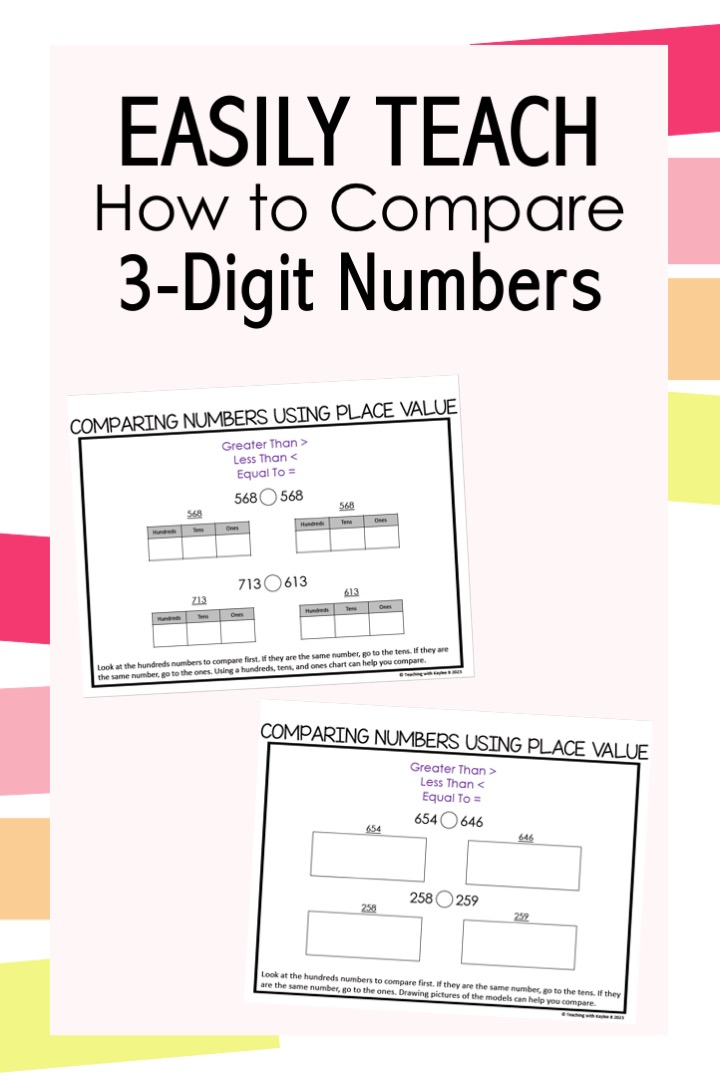
These display pages make it easy when teaching how to compare 3 digit numbers. Just project them up and they guide you on what to do and say.
I have display pages that I use as slides to help teach comparing 3 digit numbers. This helps make these visual for students. It also makes it super easy for me because it walks me through examples and what to say to my students. Find these display pages here.
I like to give students lots of practice with comparing numbers. Here’s how I do that with guided practice, independent practice, and additional practice.
Comparing 3 Digit Numbers Worksheet and Activities
For guided practice, I have students do a comparing 3 digit number worksheet. These problems have the same format as the practice problems in the display pages, so they set students up for success.
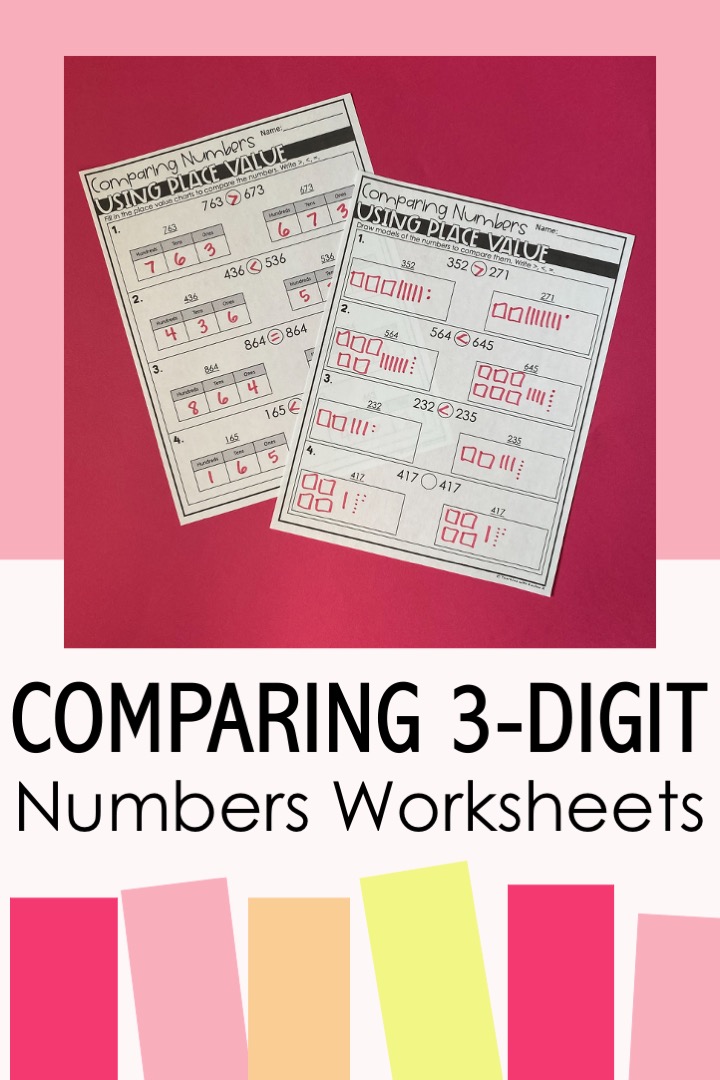
Using a comparing 3 digit numbers worksheet can be great for guided practice or independent practice.
We do the first one together and then students do the rest by themselves. As they are working on those problems, I am walking around and giving support. I take a mental note of common mistakes and misconceptions. Then after students are just about done with that, I call their attention back to me and we go over those common mistakes and misconceptions. We quickly solve those problems as a class so that students can fix any mistakes.
Then it is time for independent practice. I also like to do this by having students complete another comparing 3-digit numbers worksheet. Students get started on that and then I wait by our classroom table with one of my smelly markers.
As students finish, they come line up by my table and I quickly review their work with them. After I have helped them fix any mistakes, I give them a big check mark with the smelly marker. Students put that page in their Take Home Binder and parents are able to see how they are doing with the concept. I like doing things this way because I can give students immediate feedback. Also, I don’t have to correct any of these comparing 3 digit number worksheets during my prep time.
After that, I give students additional practice with comparing 3-digit numbers. I like to do that with a scoot activity. For this activity, I tape different problems up around the room.
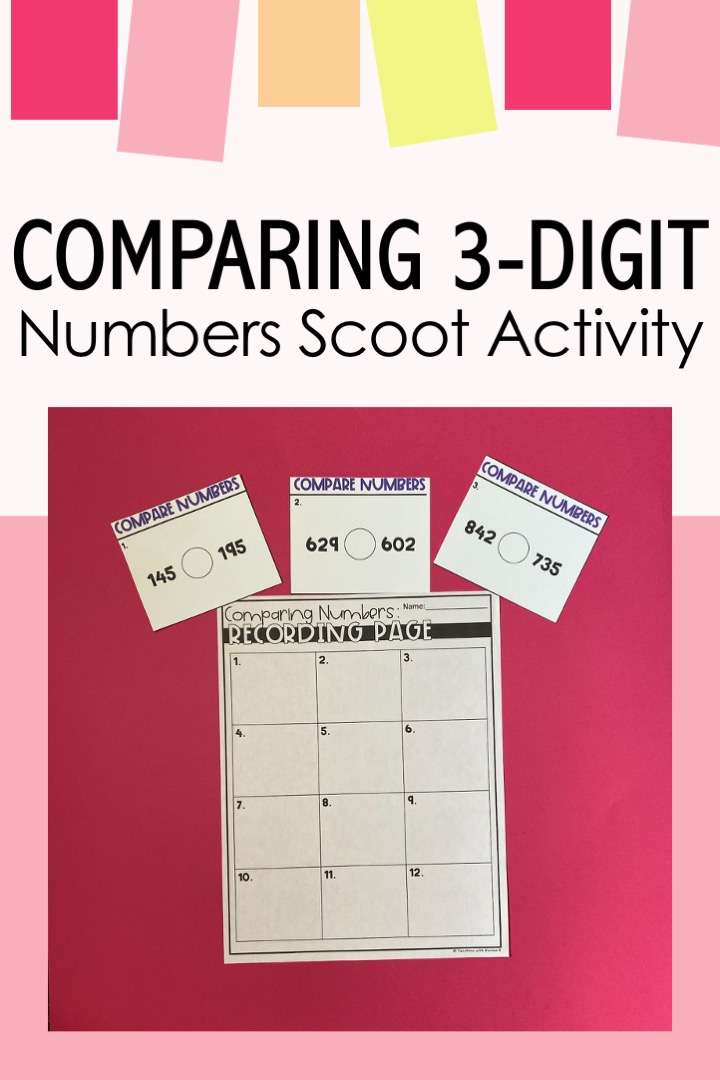
Help students get extra practice when they learn how to compare 3 digit numbers with this engaging scoot activity.
Students go around with a partner and record the answers on a recording sheet. Then I have them self-check their work with an answer key. Students use a red pen to fix any mistakes. Then this page goes in their Take Home Binder.
After that, I have students work with that same partner to complete a fun comparing 3 digit numbers sorting activity. They have a set of cards with 2 numbers on them. Students set out the greater than less than, and equal to headers. Then they sort the cards on what symbol correctly compares the 2 numbers. When students are finished, I have them raise their hands. I come over and quickly look over their work and help fix any mistakes. Then they mix up the cards, stack them up, and they are ready for the next set of students.
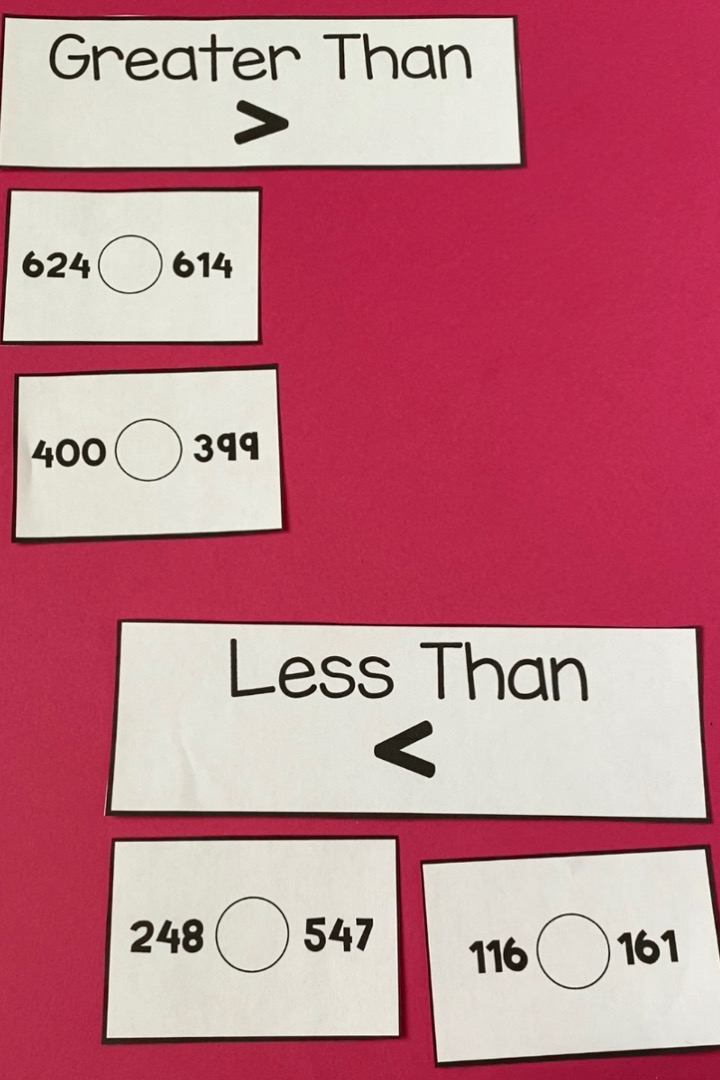
Help students use place value to compare numbers with this fun sorting activity.
Keyword: comparing numbers place value
I love how having students work with a partner for these comparing 3-digit number activities gets them talking about the math. As I am walking around my classroom monitoring them, I hear them say things like, “They both have the same number of hundreds, that means we need to look at the tens.” It makes my teacher heart so happy!
After that, I want to see how my students really understood this lesson. So I have them complete a little exit ticket individually. These have a couple different problems where students compare 3-digit numbers. They also rate themselves on how they feel they understand this concept.
After school, I’ll quickly look over these and take note of the students who could use some extra practice. I pull out some other comparing number worksheets and activities for them to do during centers.
Find all of these worksheets, activities, exit tickets I use in this lesson here.
Comparing 3-digit numbers can be a tricky concept for many 2nd graders. So the next day, I have another lesson on it. This one is set up the same. I use display pages for direct instruction, I have students do worksheets for guided practice and independent practice. Then I get students additional practice with a scoot activity and a sorting activity. But this time the topic of the lesson is just a tad bit different.
Instead of having students put in the symbol to make the comparison correct, the symbol is already given and students have to determine if it’s a correct comparison or not. On some, they have to write in a number to make the comparison true.
I like this lesson because it gets students reading the comparisons like a sentence. It really helps them learn what these symbols mean.
My favorite activity out of this comparing numbers lesson plan is the sorting activity. Students have a set of cards with comparisons on them. They set out headers that say correct comparison and incorrect comparison. Students work with their partner to correctly sort the cards.
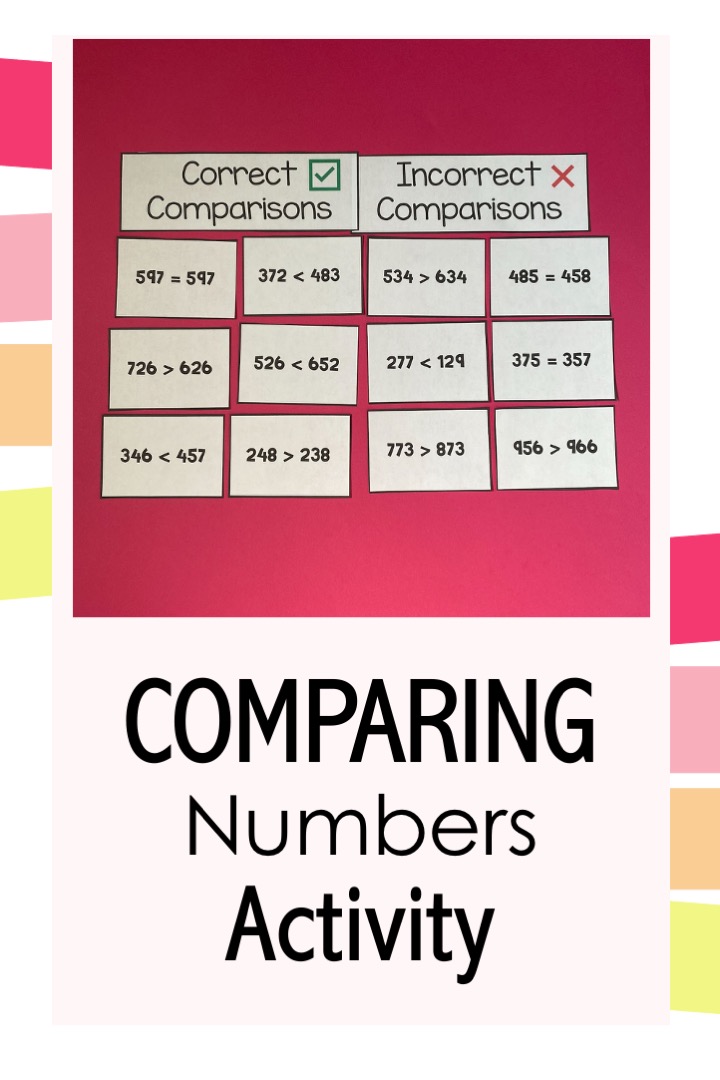
I like to add some fun into my comparing numbers lesson plan by having my students do this hands-on sorting activity.
Again, I love how students talk about the math when they complete this activity with a partner. It gets them reading the comparison like a sentence.
Find all out the materials for this comparing numbers lesson plan here.
Comparing Numbers Game
After these lessons, I like to continue to give my students practice with comparing numbers in a fun way. That is why I set out Place Value War as a fast finisher activity. When students finish their work early, they can choose to play this math game with a couple classmates. This comparing numbers game is also great as a center activity.
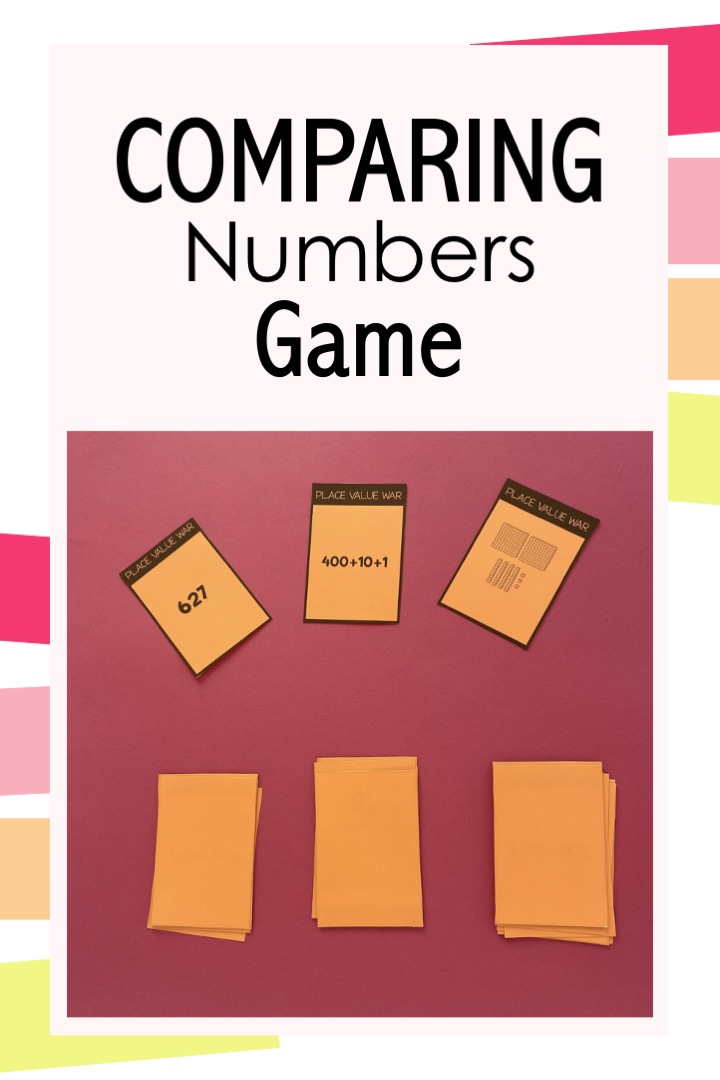
Help your 2nd grade students learn comparing 3 digit numbers with this fun comparing numbers game.
Here’s how to play this comparing numbers game. A small group of students pass out the cards to each player until all the cards are gone. Players make their pile neat but do not look at their cards. Players count to 3 and flip over their top card. Then players look at the cards and compare the numbers. The player with the highest number wins that round and puts that round’s cards on the bottom of their pile.
It’s a fun way for students to continue to practice their skills of comparing 3-digit numbers. Find this game to use in your classroom here.
I hope this blog post has given you helpful tips when teaching how to compare 3-digit numbers. I’ve found that students do better with this concept when they have a solid foundation of place value. Find all of my place value lesson materials in this bundle here.
Learn more about how to teach each 2nd grade place value standard in this blog post here: Place Value Standards: How to Best Teach Them to 2nd Grade Students
After teaching place value, it is a great time to teach 2nd grade students 3-digit addition strategies. Learn more about these in this blog post: How 2nd Graders Best Understand 3-Digit Addition Strategies
As an Amazon Associate I earn from qualifying purchases.


